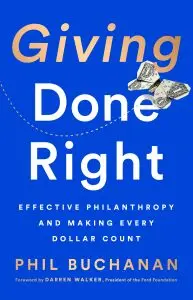In the United States, 1 in 3 people don’t trust nonprofits to spend their donations wisely. At the same time, both individuals and institutions are reluctant to contribute to basic costs like overhead, which limits groups’ ability to grow more sustainable and impactful. Both issues stem from the same major misperception. “Saying that nonprofits should operate ‘like a business’ is a meaningless phrase, but it’s one people use all the time,” says Phil Buchanan, the founder and president of the nonprofit Center for Effective Philanthropy (CEP). “They’re thinking of giving as analogous to investing when it isn’t, which leads to related mistakes like utilizing the wrong metrics [to grade success].”

As Buchanan points out in anonymized examples in the book, that hasn’t stopped some deep-pocketed donors from trying. In one case, a venture philanthropy denied a grant to the founding board member and chair of an organization that works with homeless kids because the “cost per life touched” ratio was too high, despite the fact that there was no analysis of how the group compared to others in its area. “Ratios seem rigorous, when in fact it was an inappropriate comparison, given the expense of reaching the different populations,” he says. The measurement didn’t take into account all the benefits that could occur in communities if these life changes stick either. To simplify the argument: “My friend said, ‘I could give everybody in the city a lollipop, and I would have touched a lot of lives.'”
Another issue is that donors often want groups to scale what’s working quickly without accounting for whether it would be as effective if it expanded. That might be fine in the case of the Boston-based nonprofit Bell, which offers after-school and summer programs to help at-risk kids boost and maintain their learning curves. As Buchanan points out, the group purposely crafted their curriculum so that it can be applied in many different cities, and then tested it in random controlled trials to ensure it was working (something people with MBAs don’t necessarily think about).
But it wouldn’t work for UTEC, a group that relies heavily on a local understanding of gang culture and community relationships in Boston to help steer violent gang members toward better life options. And yet UTEC has developed some basic lessons about how young people like to be directed and supported that other groups can harness in different cities. “They’ve said, ‘[I]t’s about going as deep as we can with this population here, and then sharing what we’re learning with other organizations working on similar issues in other communities,” Buchanan says.
Overall, he believes that a business-first mind-set can also devalue the contributions of nonprofit employees. Individual and institutional contributors remain reluctant to fund things like general administrative support, the bucket that organizations use to pay employees fair salaries. Ultimately, that hurts your most valuable asset. “It’s these nonprofit leaders and staff–who are doing tremendous work often on the very toughest challenges–who are the ones that have defied market solutions or government intervention.”
Recognize your brand’s excellence by applying to this year’s Brands That Matter Awards before the early-rate deadline, May 3.
